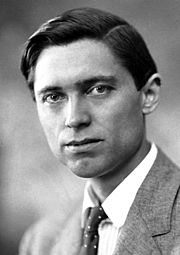Theodor Svedberg facts for kids
Quick facts for kids
Theodor Svedberg
|
|
|---|---|
 |
|
| Born |
Theodor Svedberg
30 August 1884 |
| Died | 25 February 1971 (aged 86) |
| Nationality | Swedish |
| Alma mater | Uppsala University |
| Known for | analytical ultracentrifugation Colloid chemistry |
| Awards | Nobel Prize for Chemistry (1926) Franklin Medal (1949) Foreign Member of the Royal Society (1944) Björkénska priset (1913, 1923, 1926) |
| Scientific career | |
| Fields | Biochemistry |
| Institutions | Uppsala University Gustaf Werner Institute |
| Doctoral students | Arne Tiselius |
Theodor Svedberg (born August 30, 1884 – died February 25, 1971) was a Swedish chemist. He won the Nobel Prize in Chemistry for his important work. Svedberg studied tiny particles called colloids and also proteins. He used a special machine he helped create, called an ultracentrifuge, for his research.
Svedberg worked at Uppsala University in Sweden for many years, from the early 1900s to the late 1940s. He started as an assistant and later became the head of physical chemistry. After leaving Uppsala, he led the Gustaf Werner Institute until 1967. Besides his Nobel Prize in 1926, Svedberg was also recognized by important science groups like The Royal Society and the National Academy of Sciences.
Contents
The Early Life of Theodor Svedberg
Theodor Svedberg was born in Valbo, Sweden, on August 30, 1884. His parents were Augusta Alstermark and Elias Svedberg. As a child, Theodor loved science, especially botany, which is the study of plants.
Svedberg's Education Journey
When he was in grammar school, Svedberg enjoyed doing his own science experiments. He also performed scientific demonstrations for others. For his college education, Svedberg went to Uppsala University. He studied chemistry there in the early 1900s. He earned his first degree in 1905, a master's degree in 1907, and his Ph.D. in 1908.
Theodor Svedberg's Career in Science
Svedberg began his science career at Uppsala University in 1905. He started as an assistant chemist. In 1907, he became a "docent," which is like a university lecturer. By 1912, he was made the head of the university's physical chemistry department.
Working at Uppsala University
Svedberg stayed at Uppsala University until 1949, which was a very long time. In the early 1920s, he also taught for a short time at the University of Wisconsin in the United States. After leaving Uppsala, Svedberg became the leader of the Gustaf Werner Institute. He worked there from 1949 until 1967.
Svedberg's Important Research
Theodor Svedberg's main work was with colloids. Colloids are mixtures where tiny particles are spread throughout another substance, like milk or fog. His research helped support ideas about Brownian motion. This is the random movement of particles in a fluid, first explained by scientists like Albert Einstein.
Developing the Ultracentrifuge
During his research, Svedberg created a new method called analytical ultracentrifugation. This technique uses a very fast spinning machine, the ultracentrifuge, to separate and study tiny particles. He showed how useful this machine was for telling different pure proteins apart. This was a big step forward in understanding how proteins work.
Awards and Special Honors
Theodor Svedberg received many awards for his scientific discoveries. A unit of time, called the svedberg (symbol S), is named after him. This unit is used to measure how fast particles settle in a liquid. The The Svedberg Laboratory in Uppsala is also named in his honor.
Recognitions and Prizes
In 1944, Svedberg became a Foreign Member of the Royal Society in the United Kingdom. The next year, in 1945, he joined the National Academy of Sciences in the United States. Uppsala University also gave him the Björkénska priset three times for his contributions to science in Sweden. In 1949, he received the Franklin Medal from the Franklin Institute for his work with the ultracentrifuge.
Theodor Svedberg's Later Life
Theodor Svedberg passed away on February 25, 1971, in Örebro, Sweden. He was married several times during his life and had a total of twelve children.
See also
 In Spanish: Theodor Svedberg para niños
In Spanish: Theodor Svedberg para niños

